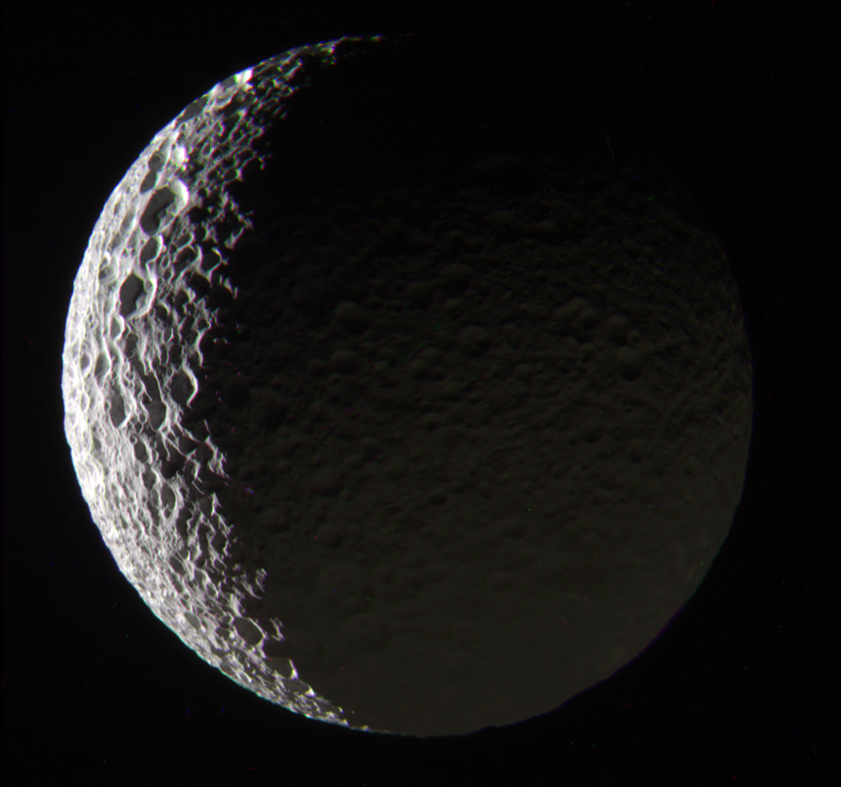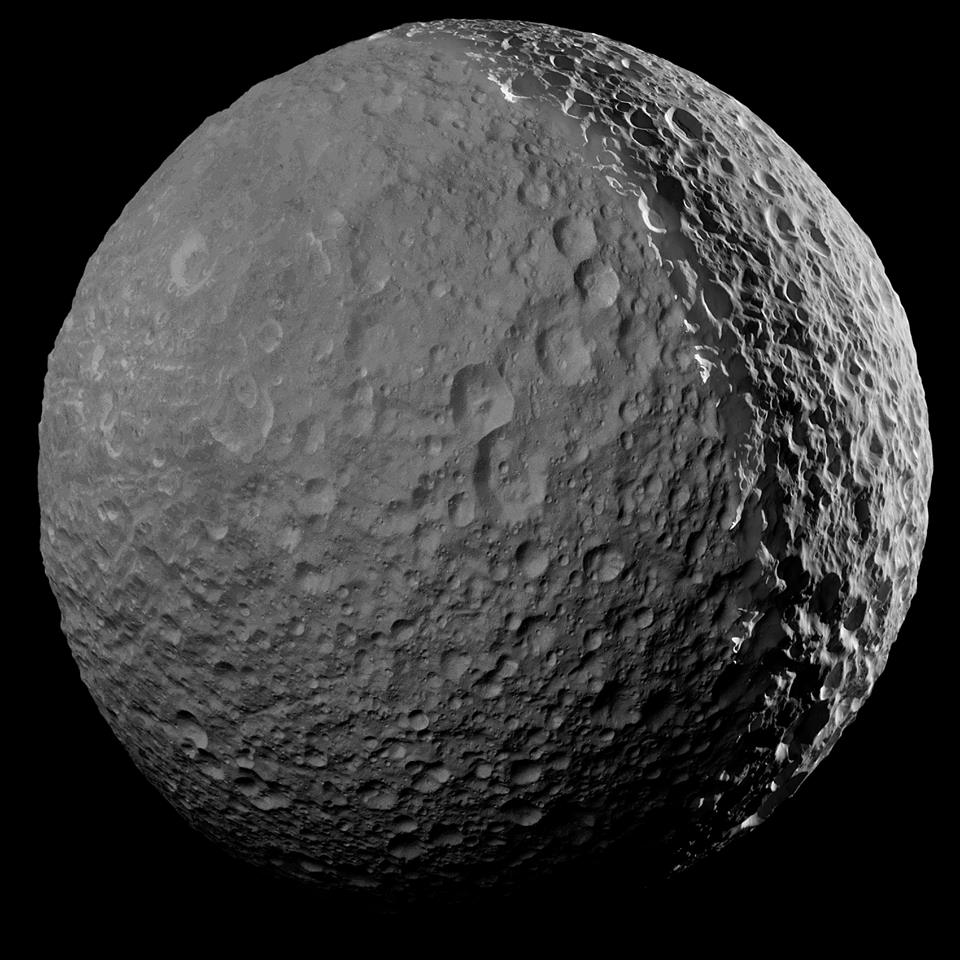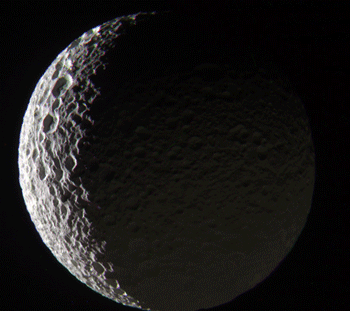It looks like you're using an Ad Blocker.
Please white-list or disable AboveTopSecret.com in your ad-blocking tool.
Thank you.
Some features of ATS will be disabled while you continue to use an ad-blocker.
share:
That is certainly a well-battered little sponge cake. Even if I had no idea of it's orbit, I would guess it to be near the main body of the debris
cloud/ring system.
Thank you. That's a great image.
Thank you. That's a great image.
a reply to: carewemust
shhh...don't speak too loud, nothing to see here.
saturndeathcult.com...
I rewatched Interstellar again the other night. Funny how they said in the movie that a wormhole appeared near Saturn to enable wormhole travel to save the Earth
If true, shouldn't the "clump" that coalesced into the Saturn and it's moons, be made of the same material..thereby causing all the moons to look nearly the same?
shhh...don't speak too loud, nothing to see here.
saturndeathcult.com...
I rewatched Interstellar again the other night. Funny how they said in the movie that a wormhole appeared near Saturn to enable wormhole travel to save the Earth
originally posted by: TheConstruKctionofLight
a reply to: hutch622
First thing i thought of was golf ball before they became cut proof
Same here - those craters look mighty deep if its diameter is 396 kms
That would be because Mimas is mostly ice rather than rock. Impacts in ice are deeper and sharper than in rock.
a reply to: carewemust
carewemust,
By the logic you are using to query the construction of Saturn's moons, their variety and disposition, one would assume that all the worlds orbiting our Sun ought to be made of largely the same things, and look relatively similar. This is, of course, flawed thinking.
Saturn and Jupiter have large gravity wells, larger than any body in the solar system other than the Sun itself. This means that their moons behaviour relative to them, is more similar to that of planets around a star, than it is to that of a mere moon around a planet.
Those moons formed out of what was left over from the formation of the planet itself, and in similar ways to the way that planets formed around the sun. The gravity well of the planet captured the chemicals of which those moons are made, and because those chemicals have different mass and weight and so on, they coalesced at different distances from the parent planet. Jupiter and Saturn are like microcosms of a solar system, having as they do complex systems of orbiting moons in their own right. When spacecraft pass through or close by Jupiter's gravity well, those craft are considered not to simply be visiting Jupiter, but to be visiting the Jovian system, for precisely this reason. You could say the same of Saturn without being in error.
carewemust,
By the logic you are using to query the construction of Saturn's moons, their variety and disposition, one would assume that all the worlds orbiting our Sun ought to be made of largely the same things, and look relatively similar. This is, of course, flawed thinking.
Saturn and Jupiter have large gravity wells, larger than any body in the solar system other than the Sun itself. This means that their moons behaviour relative to them, is more similar to that of planets around a star, than it is to that of a mere moon around a planet.
Those moons formed out of what was left over from the formation of the planet itself, and in similar ways to the way that planets formed around the sun. The gravity well of the planet captured the chemicals of which those moons are made, and because those chemicals have different mass and weight and so on, they coalesced at different distances from the parent planet. Jupiter and Saturn are like microcosms of a solar system, having as they do complex systems of orbiting moons in their own right. When spacecraft pass through or close by Jupiter's gravity well, those craft are considered not to simply be visiting Jupiter, but to be visiting the Jovian system, for precisely this reason. You could say the same of Saturn without being in error.
Another version of the true-colour image I posted earlier:

You can tell that it's ice surface, not rock.

You can tell that it's ice surface, not rock.
a reply to: wildespace
Indeed.
That glare from the crater edges in the top left quadrant of the image is clearly a reflection from ice, as opposed to some sort of metallic substance.
Indeed.
That glare from the crater edges in the top left quadrant of the image is clearly a reflection from ice, as opposed to some sort of metallic substance.
Turns out, those are Cassini's last closeup images of Mimas! All future observations of Mimas will be from more than twice this distance... So it's
time to say Goodbye, Mimas, and thanks for all the Star Wars
jokes.
Here's one of those latest shots, enhanced to better show the night side, lit by santurnshine: photojournal.jpl.nasa.gov...

Here's one of those latest shots, enhanced to better show the night side, lit by santurnshine: photojournal.jpl.nasa.gov...

I did a little image enhancement to see what details I could bring out:


new topics
-
Las Vegas UFO Spotting Teen Traumatized by Demon Creature in Backyard
Aliens and UFOs: 2 minutes ago -
2024 Pigeon Forge Rod Run - On the Strip (Video made for you)
Automotive Discussion: 51 minutes ago -
Gaza Terrorists Attack US Humanitarian Pier During Construction
Middle East Issues: 1 hours ago -
The functionality of boldening and italics is clunky and no post char limit warning?
ATS Freshman's Forum: 2 hours ago -
Meadows, Giuliani Among 11 Indicted in Arizona in Latest 2020 Election Subversion Case
Mainstream News: 2 hours ago -
Massachusetts Drag Queen Leads Young Kids in Free Palestine Chant
Social Issues and Civil Unrest: 3 hours ago -
Weinstein's conviction overturned
Mainstream News: 4 hours ago -
Supreme Court Oral Arguments 4.25.2024 - Are PRESIDENTS IMMUNE From Later Being Prosecuted.
Above Politics: 6 hours ago -
Krystalnacht on today's most elite Universities?
Social Issues and Civil Unrest: 6 hours ago -
Chris Christie Wishes Death Upon Trump and Ramaswamy
Politicians & People: 6 hours ago
top topics
-
Krystalnacht on today's most elite Universities?
Social Issues and Civil Unrest: 6 hours ago, 8 flags -
Weinstein's conviction overturned
Mainstream News: 4 hours ago, 6 flags -
Supreme Court Oral Arguments 4.25.2024 - Are PRESIDENTS IMMUNE From Later Being Prosecuted.
Above Politics: 6 hours ago, 5 flags -
University of Texas Instantly Shuts Down Anti Israel Protests
Education and Media: 8 hours ago, 5 flags -
Massachusetts Drag Queen Leads Young Kids in Free Palestine Chant
Social Issues and Civil Unrest: 3 hours ago, 4 flags -
Meadows, Giuliani Among 11 Indicted in Arizona in Latest 2020 Election Subversion Case
Mainstream News: 2 hours ago, 4 flags -
Chris Christie Wishes Death Upon Trump and Ramaswamy
Politicians & People: 6 hours ago, 2 flags -
Any one suspicious of fever promotions events, major investor Goldman Sachs card only.
The Gray Area: 10 hours ago, 2 flags -
Gaza Terrorists Attack US Humanitarian Pier During Construction
Middle East Issues: 1 hours ago, 2 flags -
2024 Pigeon Forge Rod Run - On the Strip (Video made for you)
Automotive Discussion: 51 minutes ago, 1 flags
active topics
-
Supreme Court Oral Arguments 4.25.2024 - Are PRESIDENTS IMMUNE From Later Being Prosecuted.
Above Politics • 60 • : Annee -
University of Texas Instantly Shuts Down Anti Israel Protests
Education and Media • 183 • : Threadbarer -
Las Vegas UFO Spotting Teen Traumatized by Demon Creature in Backyard
Aliens and UFOs • 0 • : FlyersFan -
Candidate TRUMP Now Has Crazy Judge JUAN MERCHAN After Him - The Stormy Daniels Hush-Money Case.
Political Conspiracies • 778 • : Annee -
Breaking Baltimore, ship brings down bridge, mass casualties
Other Current Events • 489 • : Threadbarer -
-@TH3WH17ERABB17- -Q- ---TIME TO SHOW THE WORLD--- -Part- --44--
Dissecting Disinformation • 679 • : McTech2 -
Gaza Terrorists Attack US Humanitarian Pier During Construction
Middle East Issues • 15 • : Irishhaf -
Massachusetts Drag Queen Leads Young Kids in Free Palestine Chant
Social Issues and Civil Unrest • 9 • : theatreboy -
Meadows, Giuliani Among 11 Indicted in Arizona in Latest 2020 Election Subversion Case
Mainstream News • 5 • : Disgusted123 -
God's Righteousness is Greater than Our Wrath
Religion, Faith, And Theology • 29 • : Topcraft
